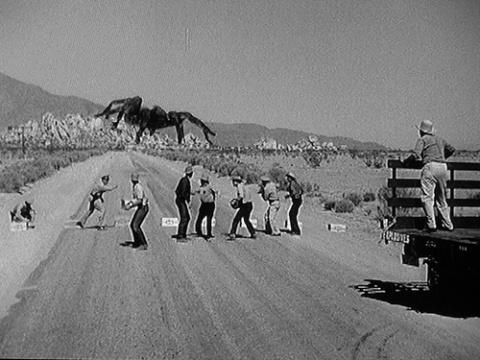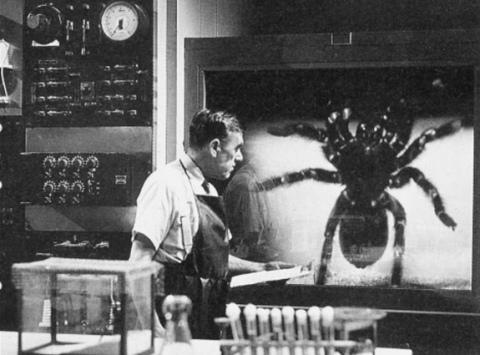
by Steve Habrat
Hot off the success of his iconic 1954 monster movie Creature from the Black Lagoon and it’s middle-of-the-road sequel Revenge of the Creature, director Jack Arnold then turned to the wildly popular science fiction subgenre of giant creature features. It may surprise you that Arnold’s 1955 arachnid outing Tarantula is one of the best creature features that may ever have the pleasure of creep across your television. Boasting special effects that would stomp some CGI effects of today, unusually strong character development for a B-movie of this breed, a unexpectedly human plot, and some truly frightening images that will have anyone who suffers from arachnophobia hyperventilating, Tarantula is a smart and surprisingly consistent creature feature that is must-see viewing for anyone who claims to be a fan of 50s science fiction efforts. To make things more fascinating, Arnold and screenwriters Robert M. Fresco and Martin Berkeley decide to turn their backs on the atom bomb willies of the Eisenhower era and instead focus on well-meaning science spinning wildly out of control. It is a nice change of pace and it allows Tarantula to stand out from the scores of giant bugs that were prowling the American countryside in the wake of the bomb. Get ready for your skin to crawl because it surely will while you take this puppy in.
Tarantula begins with the horribly deformed research scientist Eric Jacobs (played by Eddie Parker) wandering out into the Arizona desert and dropping dead. After local authorities find his body, a doctor by the name of Dr. Matt Hastings (played by John Agar) is called in to examine the disfigured corpse. Matt is baffled by the appearance of the corpse, but Matt believes that Jacobs may have been suffering from acromegaly. Matt also discovers that Jacobs was actually a colleague of Professor Gerald Deemer (played by Leo G. Carroll), a scientist that has locked himself away in a secluded mansion in the desert and has been working on creating a food nutrient that could feed the world’s rapidly growing population. It turns out that Deemer has been testing the nutrient on a variety of animals including a tarantula, which is ten times its normal size. While engulfed in his work, another colleague, Paul Lund (played also by Eddie Parker), who is suffering from the same disfigurement as Jacobs suddenly attacks Deemer. As the two men fight, they accidentally unleash the tarantula that wanders out into the desert. To make things worse, Lund injects Deemer with the nutrient, which rapidly begins to disfigure him too. As Deemer races to find a cure with his beautiful new assistant, Dr. Stephanie “Steve” Clayton (played by Mara Corday), Matt and Sheriff Jack Andrews (played by Nestor Paiva) are called to investigate bizarre skeletal remains that have been found at a local ranch. It doesn’t take long for Matt, Steve, and Sheriff Andrews to figure out that there is a giant tarantula prowling the desert.
Unlike most of the throwaway B-movies of this era, Tarantula takes its good old time crawling up to the action. For a while, you may even start to think that this movie isn’t even really about a giant tarantula attacking and destroying a small American town, but a scientist suffering from horrific mutations. Arnold spends quite a bit of time getting to know the characters, all of which are likeable enough even if they are a bunch of walking 50s clichés. When the giant abomination of science wanders out of the lab and starts creeping around the desert, Arnold generates some seriously effective suspense. He teases us with the beast’s massive legs appearing over jagged rock formations and he sends shivers as the spider’s silhouette slowly prowls the hills behind characters. There is even a wicked moment with the spider descending upon Professor Deemer’s mansion and then watching the oblivious Steve as she gets ready for bed. We only see the spider’s eyes through her window and then, in the blink of an eye, the mutant arachnid begins tearing the mansion to shreds. Arnold pulls back on the action to reveal an impressive outside shot of the spider’s silhouette reducing the mansion to splinters as Steve runs to Matt’s open arms. Tarantula’s suspense and action sequences really are top of the line for a low-budget 1955 effort.

Even though the characters are a bit clichéd and familiar for the 1950s, they are still played by the actors and actresses who are totally committed to their roles. Agar is the typical all-American hero who woos the girl and saves her from the clicking fangs of death. The poster hilariously advertised Agar holding a machine gun and firing it at the tarantula but there is never a moment like that in the film. Carroll’s Deemer is a tragic figure that is slowly succumbing to madness in his desperation to find a cure for himself. After a while, he starts to resemble the Hunchback of Notre Dame mixed with the Frankenstein monster, which is certainly a nightmarish combination. Corday is your typical damsel in distress, a pretty face who shrieks in terror when she comes face to face with the towering tarantula, however, her character is given a layer of intelligence, which is certainly a smart move on Arnold and the screenwriter’s part. Paiva is appropriately skeptical and spooked as Sherriff Andrews, who has to scramble his police force to fight back against the unstoppable monster. Film buffs should also keep their eyes peeled for a brief cameo by a very young Clint Eastwood, who shows up as a jet fighter pilot during the fiery climax of the film.
Perhaps the biggest flaw to be found in Tarantula is the rushed climax that features the tarantula barreling towards a small Arizona town. As the spider makes its way forward, jet fighters drop rockets and canisters of napalm down on the savage beast, all while the town’s citizens cheer on in support. It looks awesome but it seems cut short with “The End” plastered on the screen before we even have time to catch our breath. Mind you, there is plenty to marvel at during the final showdown, the neatest moment coming in a subtle tribute to Godzilla, which is up to you to find, but you are left wanting a bit more closure from the characters. Overall, even if it may not be dealing directly with radiation and nuclear weapons, Tarantula still cleverly captures a nation’s fears of science going horribly wrong. It may be B-movie material, but it is far from the construction paper and rubber mask approach that many of these films received. It is apparent that the filmmakers really took their time and created something they could be proud of. Tarantula is a true creature feature classic that will thrill and chill for many years to come.
Grade: B+
Tarantula is available on DVD.
